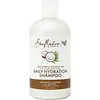What's inside
What's inside
 Key Ingredients
Key Ingredients

 Benefits
Benefits

 Concerns
Concerns

 Ingredients Side-by-side
Ingredients Side-by-side

Water
Skin ConditioningSodium Methyl Cocoyl Taurate
CleansingSodium Coco-Sulfate
CleansingSodium Chloride
MaskingCoco-Betaine
CleansingLactic Acid
BufferingParfum
MaskingPPG-5-Ceteth-20
EmulsifyingSodium Lauroyl Glutamate
Propylene Glycol
HumectantPEG-55 Propylene Glycol Oleate
Salicylic Acid
MaskingBenzoic Acid
MaskingGuar Hydroxypropyltrimonium Chloride
Skin ConditioningCoconut Alcohol
EmollientSodium Sulfate
Cocos Nucifera Oil
MaskingCoumarin
PerfumingWheat Amino Acids
Skin ConditioningFumaric Acid
BufferingHydroxypropyltrimonium Hydrolyzed Wheat Protein
Skin ConditioningPhenoxyethanol
PreservativeDisodium EDTA
Potassium Sorbate
PreservativeWater, Sodium Methyl Cocoyl Taurate, Sodium Coco-Sulfate, Sodium Chloride, Coco-Betaine, Lactic Acid, Parfum, PPG-5-Ceteth-20, Sodium Lauroyl Glutamate, Propylene Glycol, PEG-55 Propylene Glycol Oleate, Salicylic Acid, Benzoic Acid, Guar Hydroxypropyltrimonium Chloride, Coconut Alcohol, Sodium Sulfate, Cocos Nucifera Oil, Coumarin, Wheat Amino Acids, Fumaric Acid, Hydroxypropyltrimonium Hydrolyzed Wheat Protein, Phenoxyethanol, Disodium EDTA, Potassium Sorbate
Water
Skin ConditioningDecyl Glucoside
CleansingCocamidopropyl Betaine
CleansingSodium Lauroyl Lactylate
EmulsifyingGlycol Stearate
EmollientGlycol Distearate
EmollientSodium Cocoyl Isethionate
CleansingSodium Methyl Cocoyl Taurate
CleansingGlycerin
HumectantCocos Nucifera Oil
MaskingCaprylic/Capric Triglyceride
MaskingButyrospermum Parkii Butter
Skin ConditioningAloe Barbadensis Leaf Juice
Skin ConditioningPanthenol
Skin ConditioningAlgae Extract
EmollientEquisetum Arvense Extract
AstringentTocopherol
AntioxidantRosa Canina Fruit Oil
EmollientArgania Spinosa Kernel Oil
EmollientCoconut Acid
CleansingPrunus Amygdalus Dulcis Oil
Skin ConditioningAcacia Senegal Gum Extract
Cocos Nucifera Fruit Extract
EmollientCocos Nucifera Fruit Juice
EmollientCaprylhydroxamic Acid
Caprylyl Glycol
EmollientGuar Hydroxypropyltrimonium Chloride
Skin ConditioningSodium Benzoate
MaskingPolyquaternium-7
Sodium Phytate
Stearamide Amp
Parfum
MaskingWater, Decyl Glucoside, Cocamidopropyl Betaine, Sodium Lauroyl Lactylate, Glycol Stearate, Glycol Distearate, Sodium Cocoyl Isethionate, Sodium Methyl Cocoyl Taurate, Glycerin, Cocos Nucifera Oil, Caprylic/Capric Triglyceride, Butyrospermum Parkii Butter, Aloe Barbadensis Leaf Juice, Panthenol, Algae Extract, Equisetum Arvense Extract, Tocopherol, Rosa Canina Fruit Oil, Argania Spinosa Kernel Oil, Coconut Acid, Prunus Amygdalus Dulcis Oil, Acacia Senegal Gum Extract, Cocos Nucifera Fruit Extract, Cocos Nucifera Fruit Juice, Caprylhydroxamic Acid, Caprylyl Glycol, Guar Hydroxypropyltrimonium Chloride, Sodium Benzoate, Polyquaternium-7, Sodium Phytate, Stearamide Amp, Parfum
Ingredients Explained
These ingredients are found in both products.
Ingredients higher up in an ingredient list are typically present in a larger amount.
Cocos Nucifera Oil is obtained from the kernels of the coconut fruit. In other words, this is coconut oil.
Coconut Oil is rich in fatty acids with lauric acid making up the majority of these. It also contains linoleic acid. Due to this high fatty acid content, coconut oil helps trap moisture and soften skin.
Despite being antibacterial, coconut oil may not be great for acne-prone skin. It is comedogenic and may clog pores. This ingredient may not be safe for malassezia or fungal acne.
Note: Coconut Oil should not replace your sunscreen for UV protection. Studies show it only blocks about 20% of UV.
This oil is non-volatile and has a light scent.
The term 'fragrance' is not regulated in many countries. In many cases, it is up to the brand to define this term. For instance, many brands choose to label themselves as "fragrance-free" because they are not using synthetic fragrances. However, their products may still contain ingredients such as essential oils that are considered a fragrance.
Learn more about Cocos Nucifera OilThis ingredient is derived from guar gum.
It is a conditioning ingredient, meaning it helps soften skin and hair.
Parfum is a catch-all term for an ingredient or more that is used to give a scent to products.
Also called "fragrance", this ingredient can be a blend of hundreds of chemicals or plant oils. This means every product with "fragrance" or "parfum" in the ingredients list is a different mixture.
For instance, Habanolide is a proprietary trade name for a specific aroma chemical. When used as a fragrance ingredient in cosmetics, most aroma chemicals fall under the broad labeling category of “FRAGRANCE” or “PARFUM” according to EU and US regulations.
The term 'parfum' or 'fragrance' is not regulated in many countries. In many cases, it is up to the brand to define this term.
For instance, many brands choose to label themselves as "fragrance-free" because they are not using synthetic fragrances. However, their products may still contain ingredients such as essential oils that are considered a fragrance by INCI standards.
One example is Calendula flower extract. Calendula is an essential oil that still imparts a scent or 'fragrance'.
Depending on the blend, the ingredients in the mixture can cause allergies and sensitivities on the skin. Some ingredients that are known EU allergens include linalool and citronellol.
Parfum can also be used to mask or cover an unpleasant scent.
The bottom line is: not all fragrances/parfum/ingredients are created equally. If you are worried about fragrances, we recommend taking a closer look at an ingredient. And of course, we always recommend speaking with a professional.
Learn more about ParfumThis gentle cleansing and foaming ingredient is known for leaving a smooth feeling in skin and hair. It is made using coconut oil.
According to the manufacturer, it is soluble in water and has resistance to hard water, acid, and alkali.
Due to its coconut base, it may not be Malassezia folliculitis safe.
Learn more about Sodium Methyl Cocoyl TaurateWater. It's the most common cosmetic ingredient of all. You'll usually see it at the top of ingredient lists, meaning that it makes up the largest part of the product.
So why is it so popular? Water most often acts as a solvent - this means that it helps dissolve other ingredients into the formulation.
You'll also recognize water as that liquid we all need to stay alive. If you see this, drink a glass of water. Stay hydrated!
Learn more about Water